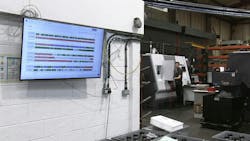AVPE Systems, a subcontracting machine business that works primarily for Airbus and Airbus suppliers, started in 2021 by the merger of Avon Valley Precision Engineering and Redcliffe Precision. Eighteen months ago, management at AVPE faced up to the fact that the shop floor at their 75-employee plant in Bristol, England, did not meet the productivity targets.
They couldn’t quantify the source, but knew productivity could and should have been higher.
“The amount of product that was getting made didn’t match the expectation based on the amount of manpower and the amount of hours that were available. We were aware that we had good weeks and bad weeks but couldn’t quite pinpoint why we had the bad weeks,” says Sean Thomas, head of operations at AVPE.
It wasn’t a technical or engineering issue. AVPE eliminated other potential causes by fixing its quality management system (QMS), uncovering pre-production bottlenecks like ineffective launch reviews, adequately preparing the shop floor to produce new products and last-minute job prioritization changes.
There was one odd hint, though. As the number of operators on the floor fluctuated, due to normal hiring and resignations, output didn’t change. The productivity issue had something to do with the way the AVPE managed its people.
Sean Thomas, Head of Operations, AVPE
Monitor Machines, Not People
AVPE had deployed a camera-based machine monitoring system that generated downtime codes when machines stopped running. The system was hardwired, therefore any time the company acquired new machines or floor layouts changed, technicians had to reposition or install ethernet cabling. It was difficult to maintain the system as the company grew, especially after the 2021 merger and acquisition of so many new machines.
Operators also used a paper-based system to report uptime, downtime and reasons for downtime, but Thomas found operators mostly cited annoyances like waiting for engineers, materials or answers from quality. Those things happen, Thomas says, but not often enough to explain AVPE’s productivity issues.
“I’d constantly get told the biggest reason that the productivity is not good is because I’m always wandering around looking for this tool or looking for that tool, looking for this fixture or that fixture, and then when you’ve got the data, [it turns out] that wasn’t the reason, because they were doing that while the machines were running,” Thomas says.
AVPE’s managing director comes from an IT background and understands the importance of making data-driven decisions, says Thomas, so after a brief conversation the company decided in January 2023 to pilot the FourJaw machine monitoring system.
It uses WiFi-enabled, plug-and-play, off-the-shelf sensors to feed data into software that provides real-time feedback on machine status. Thomas limited the pilot to five of the plant’s 25 machines on the shop floor.
“I didn’t want us to kit out all the machines with all the sensors and then have a bit of a nightmare in terms of having to teach everyone at once how to use it and find all the problems at once, and just having a load of data that wasn’t usable,” says Thomas.
He also wanted to give operators a chance to see the system in action and dispel concerns about using data to track individual operator performance. Long-serving operators didn’t want to be monitored because they felt the company ought to trust them, or operators said they already knew they did a good job, so why did the company have to monitor the machines?
Thomas says monitoring single operators was truly never the point of installing the system.
“In the early days [of the pilot] we found that the most common [problem was] a machine stopping early on a night shift. We only asked, ‘We can see the machine stopped. What was the problem?’ We never went and asked the person what they were doing, because we were very clear from the beginning that this was about monitoring the machines, not the people. We openly said to people, ‘If all the machines that are supposed to be running are running, we don’t care what you’re doing. Your job is to keep the machines running,’” Thomas says.
Once this reporting became the norm and performance improved on the machines monitored during the pilot, it changed the culture on the shop floor to a sense of friendly competition, to see which sections could improve the most. Cell leaders went from making sure people worked at all to directing them on what tasks to complete and monitoring quality results.
Boards on the shop floor display color-coded data to indicate whether machines are running and if not, why they're not.
When Data Problems Become People Problems
By mid-August 2023, every machine on the floor had an IoT device feeding data into the new machine monitoring software. Every IoT device supports a tablet. If a machine stops working for more than a few minutes, the operator on the tablet enters a code to explain the downtime.
Boards on the shop floor display color coded results to differentiate between downtime with a reason from downtime awaiting explanation. In addition to monitoring machine health, Operators can use the information to address changeovers happening slower than usual.
AVPE pulls the data into spreadsheets to conduct daily, weekly and monthly analyses. The reports quickly made clear how five minutes of downtime here and ten minutes of downtime there really added up to meaningful losses of productivity. Data analysis also validated Thomas’s gut feeling that workforce management played a role in AVPE’s productivity issues.
“I try and always take the view that there’s a systematic cause to most of the things that go wrong. … Once you start reacting to the data and not the people, you then start driving [better workforce management] automatically,” Thomas says.
The problem: Not enough people on the shop floor. Thomas realized that AVPE had made bad assumptions about the number of machines an operator could run efficiently.
One operator could technically run three machines but if one machine went down, the other two effectively also went down while the operator addressed the issue. The data clearly showed AVPE required more operators and the company launched a recruitment drive.
“We also found that skill level wasn’t quite aligned in some places. … We noticed, when we first started [getting data], one of our big downtimes was helping others. There were a few individuals who were having to go and help other people quite a lot, and people had become dependent on them…five minutes at a time, but very consistent, very frequently throughout the day,” says Thomas.
AVPE created new training programs and instituted more rigorous sign-off policies. Operators who performed well on machines but didn’t understand the task couldn’t notice when engineering data or programs running on machines weren’t quite correct. They might have excelled at manufacturing a specific number of parts on a machine but trying to manufacture new, unfamiliar parts might turn the job to scrap.
Egos dented and the company lost some operators no longer allowed to perform the same tasks as before the new sign-off policy began. In some cases, AVPE replaced those operators with new employees with no machining experience but who also, thanks to the new training structure, could onboard much faster.
Between additional operators, new training and creating an improvement-based culture, two months after the rollout completed, uptime increased by 30% and productivity increased by 10% to 15%.
The Fringe Benefits of Undeniable Solutions
While AVPE didn’t deploy the machine monitoring system to solve the annoyances operators reported with the old paper-based system, the changes AVPE made from chasing the data did solve at least one recurring complaint from some of the operators, the need to help others by answering the exact same questions over and over again.
“Machine monitoring doesn’t fix things itself. It gives you the information to go and fix what needs to be fixed. Whether you like what you find or not, it is quantifiable, and at that point you have to go deal with it,” says Thomas.
About the Author
Dennis Scimeca
Dennis Scimeca is a veteran technology journalist with particular experience in vision system technology, machine learning/artificial intelligence, and augmented/mixed/virtual reality (XR), with bylines in consumer, developer, and B2B outlets.
At IndustryWeek, he covers the competitive advantages gained by manufacturers that deploy proven technologies. If you would like to share your story with IndustryWeek, please contact Dennis at [email protected].



